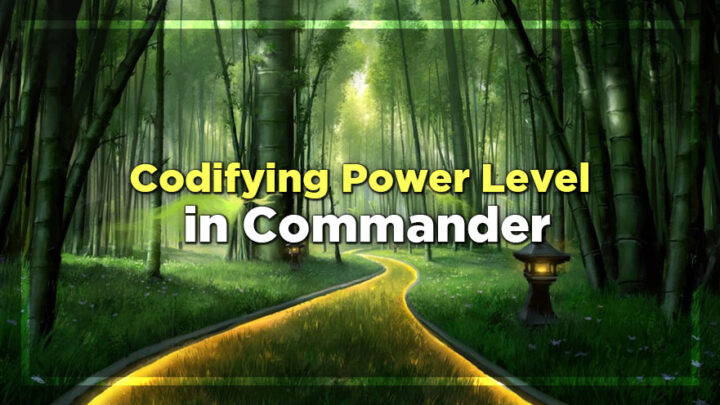I don’t think of Commander as a format.
Now that I have your attention, I should probably explain myself. To me, Commander is less of a format, and more like a framework. When you call something a format, that implies there is a strict set of rules by which to define it. When you play Modern, Pauper, or Pioneer, there are rules to follow if you are to play; in Commander, however, Rule Zero allows you to tweak and set the rules as you and the table see fit. This is an important distinction, as it allows for all manner of gameplay – it’s how players can play their Chair Tribal decks in one game, and high-end competitive builds in the next.
Aside from Rule Zero itself, power level is the most important aspect of every game. It’s also the trickiest to get right. I had referenced this in my piece on Commander New Year’s Resolutions in January, and I’ve since been trying to find a way to expand on and improve how we approach power level conversations. Then, I came across these tweets from Alex from The Spike Feeders, which really resonated with me:
In the abstract, power levels should be simple enough to figure out, but the imbalance that many players often experience shows that theory is very different from practice. The idea that power levels can be codified to improve communication makes a lot of sense, and I believe that universal adoption of this principle would increase the average game quality dramatically.
What is a Codified Power Level?
A codified power level is almost like a format within a format, complete with its own set of rules and restrictions. To codify a power level, you take your ideal Rule Zero considerations that you would like to play with and simply add a name to it.
The perfect example of a codified power level is cEDH. All players sitting down to a game of cEDH knows that they’re supposed to build their decks optimally, play optimally, and play to win. It’s still Commander, but it’s a specific mindset and ruleset explicitly defined through Rule Zero, and it has been given the label of cEDH so players can easily find each other.
Why Codify Power Levels?
Labeling power levels like this can be very beneficial, most notably because it allows you to be extremely clear when it comes to setting expectations. When was the last time you heard of a cEDH player sitting down to play, only to find out that the game wasn’t the power level they expected? This is the benefit of having such a specific label.
This approach is very different from the oft-seen “number scale,” despite seeming similar at first glance. The difficulty with calling a deck “mid” or a “7 out of 10” is that meaning varies wildly from player to player. Is fast mana okay? What about infinite combos? How fast can your deck win? Do you use tutors? None of these questions are answered with a number on a linear scale. It’s also impossible to convey whether the primary goal is to enjoy the game and its interactions, let everyone do their thing, or to win. Applying a label to a collection of these elements can make it much easier to communicate, and it shortens the time you need to spend on pregame conversations.
Existing Coded Power Levels
There are a number of existing power levels within Commander beyond cEDH. Some limit the pool of cards in the format to provide a different kind of gameplay, like Artisan or Pauper EDH. While a modified card pool doesn’t codify the mindset of the format – whether players are looking to play a more competitive game or something more relaxed – it goes a long way toward setting the right expectations.
Conversely, power levels can be more abstract, like Commander Sphere’s Lasagna Tier:
This obviously is much more open to interpretation when it comes to cards that are welcome and those that aren’t, but it places more emphasis on the enjoyment of the game than maintaining a prescriptive card pool or rule set. This will suit many people, but it won’t suit everyone; this is exactly why it’s so important to find what works for you and to identify it.
So many players play with unaltered preconstructed decks that even “Precon” could be considered its own power level now. As the vast majority of preconstructed decks are built with the same general philosophy, it’s easy to see how it could develop its own player base that enjoys its play style. Even more advanced brewers could benefit from working with this power level; I’ve talked before about how restrictions breed creativity, and building to match power and deck building philosophy with preconstructed decks presents its own unique and engaging challenge!
More Coded Power Levels To Try
If none of those existing power levels tickle your fancy, there are countless others that are close to becoming their own concrete pillars for play. I’ll cover a few here to give you some inspiration, or just a solid place to start.
There is a sizable subset of players that don’t enjoy combos, and “No Combos” has already been used as a beacon to assemble like-minded players. It’s still important to note that this doesn’t cover all cases, and some specificity might be needed to help this variant come into its own. Are you talking explicitly about two-card combos, or are three-card combos included? What if the commander is part of a five-card combo? Are you looking to only avoid decks whose primary win condition is an infinite loop? This is the level of detail that’s needed to create a codified power level, but the good news is once it’s done, it’s done. It’s work, but as Alex said in his tweet in the beginning: “it’s just work.”
I often play at a budget level, usually between $50 and $150 for a deck. This may seem relatively arbitrary, and it is, but it goes a long way toward narrowing down the range of playable power. More powerful cards tend to cost more, so it’s often a self-regulating environment. It’s by no means perfect, and it still requires some amount of pregame talk, but it’s a solid start for its own fair and balanced power level.
Since there are more paper Commander streams than ever before (thanks to SpellTable), there seems to be a new, unwritten power level coming into its own that shows up at a lot of these tables. It’s all about building and playing with entertainment as the primary influence, and ensuring that the plays are as engaging as possible. This usually means that interaction often gets held back so that players can show off their decks, and when someone has assembled a flashy win around the hour mark, the game usually ends (even if someone had a removal spell). It often feels like the decks are built to help fulfill a role within a table’s dynamic, and are well equipped to adapt to the atmosphere at any given time. This feels a lot like Lasagna Tier, but there’s enough subtlety to warrant its own label.
Speaking of streams, there are many content creators that are known for playing at specific power levels; this could be used to your advantage, by using them as a reference point. A Game Knights deck will feel very different from a MTGMuddstah deck, which is entirely different to a ManaCurves deck. If you told me “I’m playing a deck that would fit in on I Hate Your Deck,” then I’ll know I can match that by playing with my tuned Syr Konrad, the Grim deck, rather than my Moritte of the Frost Changelings deck. And if I didn’t know, there’s an entire catalog of content I can reference to get an understanding of the kind of power level and play philosophy that you’re seeking.
What Else Can I Do?
Sometimes, it’s not really feasible to create a labeled power level, but that doesn’t mean you’re out of luck. You can take another leaf out of cEDH’s book and repurpose it: create a primer for your deck. While cEDH primers tend to be quite long, they don’t have to be the same for casual decks. It could be a paragraph or two, with some basic information about the deck and how it operates.
Here is the micro primer for my Laelia, the Blade Reforged deck:
This is an aggressive midrange deck. It uses Laelia as a primary win condition, and makes use of discard synergies in addition to exile-based card advantage to keep up with the rest of the table. The only fast mana is Sol Ring, there are no infinite combos, and there is only one extra combat spell (Seize the Day). There is minimal protection and evasion for Laelia, but there is a reasonable amount of value and interaction to ensure you never fall behind if she is removed.
Generally, you don’t want to play a land before combat, as Laelia could hit one when she attacks. Many exile effects are instant-speed, like a Relic of Progenitus activation, so they can be used as combat tricks. One of the most powerful cards in the deck is Bloodbraid Marauder; as there are very few one-drops, it will regularly add several counters to Laelia, often making her a one-hit kill.
You can show these micro primers to players to give them an idea of what you’re playing. This will help them to make better, more informed decisions about their own deck choice, and will help lead to more enjoyable games. You don’t even have to give as much information as I did here; even the first half is plenty of information to help prime the table for a good time!
Finally, you can also prepare a pregame conversation for each of your decks. This can be very simple, with extremely basic information, which you can then copy/paste and update across your collection. It may not seem like much, but it’s a lot more accurate in communicating power level than a single digit on a linear scale ever will be. Rachel Weeks of the Commander Advisory Group even suggested a template for this recently!
Ultimately, Commander is all about having fun. Finding like-minded players with similar expectations is important, and that’s why communication of power levels is so important. The power level discussion is something that the community has revisited every couple of months, and it often feels like a problem that will never be solved. However, I believe that it’s possible – we just have to be willing to try something different for the sake of the format as a whole. It’s work, sure, but it’s just work.
How do you approach power level discussions with the people that you play with? Do you have any other ideas on how to tackle such a tricky task? I’d love to hear your thoughts, so be sure to let me know over on Twitter!

Scott is an Irish content creator and the Head of Budget Magic for the Izzet League. He focuses on affordable decks in Pioneer, Modern, and Pauper, particularly ones that stray from the mainstream. When he’s not writing about his favorite decks, he can be found talking incessantly about them on Twitter and on The Budget Magic Cast.

